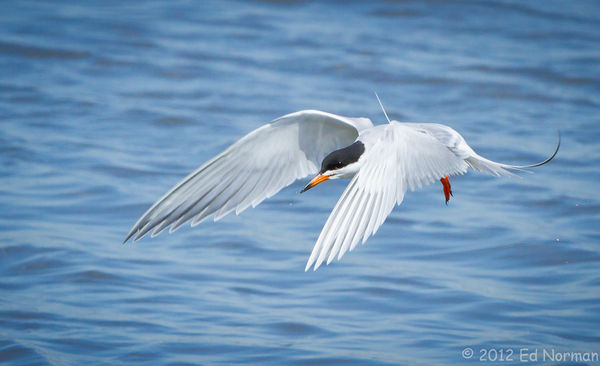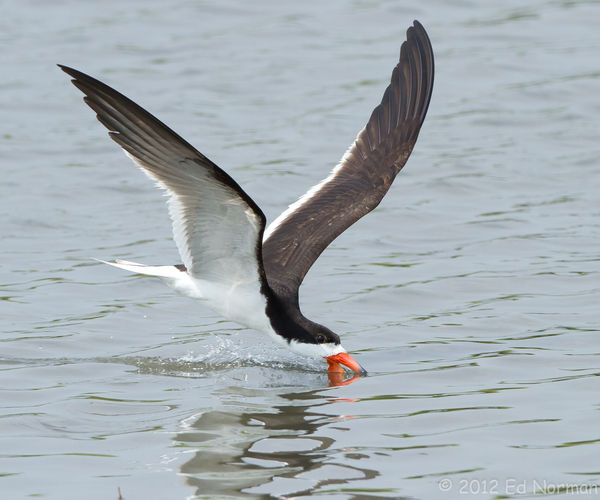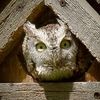Shooting birds in the air
Apr 8, 2012 05:57:25 #
.When I visit the Gulf coast, I get the opportunity to photograph interesting birds in the air, sometime from a boat and sometimes from the shore. They move fast, auto focus is undependable. Sometimes they are 15 ft and sometimes 40 ft from the camera. Are there suggestions on how to get a good photo of a flying bird. ie: distance setting, f stop, ISO, etc (and lens) and strategy.
Jim
Jim
Apr 9, 2012 06:56:24 #
Ann B
Loc: Northeast Indiana
jrlatham4567 wrote:
.When I visit the Gulf coast, I get the opportunity to photograph interesting birds in the air, sometime from a boat and sometimes from the shore. They move fast, auto focus is undependable. Sometimes they are 15 ft and sometimes 40 ft from the camera. Are there suggestions on how to get a good photo of a flying bird. ie: distance setting, f stop, ISO, etc (and lens) and strategy.
Jim
Jim
I want to see the answer to this one too!
Apr 9, 2012 07:47:32 #
It depends on what camera and lens combination you are using. If it is a dslr with a good tele lens you should be able to use autofocus tracking mode and high speed shutter( from 3 -10 frames per second). Also helps to use Av mode on Canon or Ap on Nikon(not sure on this). Set your aperture so your shutter speed is above 1/500th second. Remember your DOF is determined by aperture, so for more DOF use a smaller aperture or larger number f-stop. This depends on the available light you have as well as how fast a lens you are using. I usually will start with f4-5.6 and see what I get. Set your ISO to a higher number if you need to in order to get the SS to 1/500th or above to stop action.
With a P&S or bridge camera it can be more difficult but still doable. You just won't get many keepers.
It is a practice thing so just work on it and it will get easier.
Hope this helps.
With a P&S or bridge camera it can be more difficult but still doable. You just won't get many keepers.
It is a practice thing so just work on it and it will get easier.
Hope this helps.
Apr 9, 2012 07:52:47 #
I don't understand why you don't think AF works? Do you have it set right? I use spot and continues focus. I have just found an Eagles nest that is close to home. The nest it's self is about 75 yards from where I can shoot. And there are a lot of trees around. But with my settings, the AF will even find the moving bird through some of the trees too. Not all are in focus, but if I tried manual I don't think I would get any shots. They do move fast!.
As far as lenses. The biggest bestess lens you have! So far I keep the camera in auto, this lets me look at the settings the camera is picking. This is my first Eagle pictures and he is flying in the sky and down through the trees. I have looked at the settings it is picking and now I can go manual if I need to.
Here are a few links to my shoots.
http://www.uglyhedgehog.com/t-33853-1.html
http://www.uglyhedgehog.com/t-33707-1.html
I used my 28-300 on these. I went out just to check out the area the first 2 times. Now I will take out the 300 f2.8 and see what it will do. Have the TC1.4 and the TC 2 to try out.
Erv
Forgot to add, I have the focus set to the back AF-ON button. I just keep my thumb on it and it is trying to focus all the time on continues.
As far as lenses. The biggest bestess lens you have! So far I keep the camera in auto, this lets me look at the settings the camera is picking. This is my first Eagle pictures and he is flying in the sky and down through the trees. I have looked at the settings it is picking and now I can go manual if I need to.
Here are a few links to my shoots.
http://www.uglyhedgehog.com/t-33853-1.html
http://www.uglyhedgehog.com/t-33707-1.html
I used my 28-300 on these. I went out just to check out the area the first 2 times. Now I will take out the 300 f2.8 and see what it will do. Have the TC1.4 and the TC 2 to try out.
Erv
Forgot to add, I have the focus set to the back AF-ON button. I just keep my thumb on it and it is trying to focus all the time on continues.
Apr 9, 2012 08:13:33 #
AI Servo on a canon don't know about nikon would help once you achieve focus it won't change even if you move your camera to track the bird provided it doesn't move closer or farther away from you. I use it for airplane takeoffs and landings and other things that stay at the same distance gonna have to try to see how this works if your subject moves closer or further away I think I already know the answer but will try to see if I am correct.
Apr 9, 2012 08:16:18 #
Apr 9, 2012 08:45:58 #
Apr 9, 2012 11:31:26 #
jrlatham4567 wrote:
.When I visit the Gulf coast, I get the opportunity to photograph interesting birds in the air, sometime from a boat and sometimes from the shore. They move fast, auto focus is undependable. Sometimes they are 15 ft and sometimes 40 ft from the camera. Are there suggestions on how to get a good photo of a flying bird. ie: distance setting, f stop, ISO, etc (and lens) and strategy.
Jim
Jim
Make sure the Sun is not backlighting the birds. Set the shutter speed anywhere between 1/320 sec. to 1/500 sec. The lower setting will sometimes leave a slight blur on the most remote, fastest moving feathers on the wing. If you disdain auto ISO take practice shots at 400. Adjust upward if the picture is too dark. If it is only slightly too dark, then adjust with exposure compensation.
Apr 9, 2012 12:55:05 #
Gary Truchelut wrote:
It depends on what camera and lens combination you... (show quote)
Most of this is correct. A few additional thoughts: use manual exposure based on a previous test using Av mode. Doing this solves two problems. As a bird flies, the background may change, telling the exposure meter in the camera it is seeing something different. This is false since the light on the bird is always the same no matter if the sky or if dark trees are in the frame as background. The second advantage is the camera will not have to take any time before making the exposure to determine the exposure.
Another little advice I'll throw your way is think like your shooting clay birds with a shotgun. You must lead the bird and let it fly into your frame as opposed to you trying to catch up with the bird. Just relax and have great fun! J. Goffe
Remember, the f/stops here
Apr 9, 2012 13:30:41 #
I read your title fo this thread and the my first thought was use a 12 guage full choke. This would provide the longest range and a concentrated pattern of shot. Then I reembered this about cameras.
I would suggest for BIF pictures be patient. Keep shooting, may take more than one day to get the shot you want.
I would suggest for BIF pictures be patient. Keep shooting, may take more than one day to get the shot you want.
Apr 9, 2012 20:41:17 #
jrlatham4567 wrote:
.When I visit the Gulf coast, I get the opportunity to photograph interesting birds in the air, sometime from a boat and sometimes from the shore. They move fast, auto focus is undependable. Sometimes they are 15 ft and sometimes 40 ft from the camera. Are there suggestions on how to get a good photo of a flying bird. ie: distance setting, f stop, ISO, etc (and lens) and strategy.
Jim
Jim
I shoot BIF all the time. I use a Canon 7d with either a 100-400 mm Zoom or a 500 mm prime.This is what I do:
I shoot manual exposure based on a test exposure of something aprox 17% gray. In direct sunlight I am usually shooting at 1/2000 sec, at f/8, ISO 800.
My AF system is set to AI-Servo AF with AF point expansion. That is single point AF with the 4 Adjacent points active if needed. The 7d allows you to adjust AI-Servo tracking sensitivity. I set it to Slow. This prevents AF from refocusing too quickly if you get off your subject briefly or something like a telphone pole passes between the camera and subject.
I stand with my left foot forward, slightly ahead of the birds track, camera tight to my face and the barrel of the lens held in my left hand. I see a bird I want to shoot, I begin tracking it with the camera, twisting at the waist and being careful to place the AF point on the bird. I follow the bird while I half press the shutter button to activate AF. When AF is achieved I roll my finger over the shutter button to activate shutter release. I don't just mash it down as this can introduce camera shake. I continue to track the bird shooting in continuous mode until the bird is moving away from me. I release the shutter but continue to follow through with the bird.
I do not use Image Stabilization as I find that it interferes with AF acquisition and AF lock. I rely on the 1/2000 shutter speed to handle both subject movement and camera shake.
Exposure is adjusted if I am shooting white birds either by raising the shutter speed or lowering the ISO or both. f/8 seems to be a sweet spot for my lenses so I tend to stay with it.
If you are having trouble finding the bird in the viewfinder and you are using a zoom lens then zoom out, find the bird then zoom back in and initiate AF etc.
I generally don't use a tripod for BIF as I find it hinders tracking the bird as you trip over the legs when you walk around it. The only exception is when I am working along a jetty and the birds are basically following the jetty and flying in a predictable pattern of straight and level flight.
Forster Tern

Black Skimmer

Apr 10, 2012 21:10:51 #
Apr 10, 2012 21:14:16 #
Apr 10, 2012 21:15:58 #
Apr 10, 2012 21:18:41 #
If you want to reply, then register here. Registration is free and your account is created instantly, so you can post right away.








